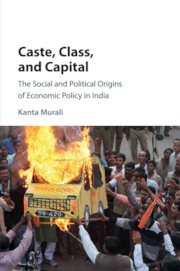Book contents
- Caste, Class, and Capital
- Caste, Class, and Capital
- Copyright page
- Dedication
- Contents
- Figures
- Tables
- Acknowledgments
- Abbreviations
- 1 Introduction: Growth-Oriented Policies and Poor Electorates
- 2 The Argument: Social Identity, Electoral Coalitions, and Investment Policies
- 3 Diverse Policy Responses to the Competition for Investment
- 4 Contrasting Coalitions and Policy Outcomes: Gujarat and Punjab
- 5 Fluctuating Coalitions and Commitments: Andhra Pradesh and Bihar
- 6 Expanding the Scope of Analysis
- 7 Conclusion
- References
- Index
- References
References
Published online by Cambridge University Press: 02 February 2017
- Caste, Class, and Capital
- Caste, Class, and Capital
- Copyright page
- Dedication
- Contents
- Figures
- Tables
- Acknowledgments
- Abbreviations
- 1 Introduction: Growth-Oriented Policies and Poor Electorates
- 2 The Argument: Social Identity, Electoral Coalitions, and Investment Policies
- 3 Diverse Policy Responses to the Competition for Investment
- 4 Contrasting Coalitions and Policy Outcomes: Gujarat and Punjab
- 5 Fluctuating Coalitions and Commitments: Andhra Pradesh and Bihar
- 6 Expanding the Scope of Analysis
- 7 Conclusion
- References
- Index
- References
- Type
- Chapter
- Information
- Caste, Class, and CapitalThe Social and Political Origins of Economic Policy in India, pp. 267 - 287Publisher: Cambridge University PressPrint publication year: 2017



